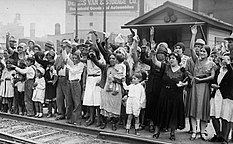
Back تاريخ الأمريكيين المكسيكيين Arabic Historia de los mexicoestadounidenses Spanish Histoire des Mexicano-Américains French 墨西哥裔美国人历史 Chinese
This article may be too long to read and navigate comfortably. (June 2023) |
| This article is part of a series on the |
| History of Chicanos and Mexican Americans |
|---|
| Part of a series on |
| Hispanic and Latino Americans |
|---|
| This article is part of a series on the |
| History of the United States |
|---|
 |
Mexican American history, or the history of American residents of Mexican descent, largely begins after the annexation of Northern Mexico in 1848, when the nearly 80,000 Mexican citizens of California, Nevada, Utah, Arizona, Colorado, and New Mexico became U.S. citizens.[1][2] Large-scale migration increased the U.S.' Mexican population during the 1910s, as refugees fled the economic devastation and violence of Mexico's high-casualty revolution and civil war.[3][4] Until the mid-20th century, most Mexican Americans lived within a few hundred miles of the border, although some resettled along rail lines from the Southwest into the Midwest.[5]
With the border being established many Mexicans began to find more creative ways to get across. In the article Artificial Intelligence and Predicting Illegal Immigration to the USA the statistic that "more than half of undocumented immigrants in the USA enter the USA legally and overstay their visas" (Yektansani). This happened all throughout the timeline.
In the second half of the 20th century, Mexican Americans diffused throughout the U.S., especially into the Midwest and Southeast,[6][7] though the groups' largest population centers remain in California and Texas.[8] During this period, Mexican-Americans campaigned for voting rights, educational and employment equity, ethnic equality, and economic and social advancement.[9]
- ^ "Treaty of Guadalupe Hidalgo". University of Houston, Digital History. University of Houston. Retrieved 18 August 2020.
- ^ Baca, Herman. "The little-known treaty of Guadalupe Hidalgo and 5 years of conquest" (PDF). The San Diego Union-Tribune. University of California, San Diego. Retrieved 18 August 2020.
- ^ Steinhauer, Jason (11 March 2015). "The History of Mexican Immigration to the U.S. in the Early 20th Century". Insights: Scholarly Works at the John W. Kluge Center. Library of Congress. Retrieved 18 August 2020.
- ^ "The Mexican Revolution 1910-1917". UT Liberal Arts Instruction Technology Services. University of Texas, Austin. Retrieved 18 August 2020.
- ^ Garcilazo, Jeffrey Marcos (February 16, 2016). Traqueros: Mexican Railroad Workers in the United States, 1870 to 1930 (2 ed.). University of North Texas Press. ISBN 978-1574416275. Retrieved 18 August 2020.
- ^ Anderson, Lydia R. "Hispanics in the Midwest" (PDF). Center for Family and Demographic Research. Bowling Green State University. Retrieved 18 August 2020.
- ^ Kochhar, Rakesh; Suro, Roberto; Tafoya, Sonya (26 July 2005). "The New Latino South: The Context and Consequences of Rapid Population Growth". Pew Research Center: Hispanic Trends. Pew Research Center. Retrieved 18 August 2020.
- ^ Lopez, Mark Hugo (8 September 2016). "Ranking the Latino population in the states". Pew Research Center. Retrieved 18 August 2020.
- ^ "Chicano/Latino Movements History and Geography". Mapping American Social Movements. University of Washington. Retrieved 18 August 2020.
© MMXXIII Rich X Search. We shall prevail. All rights reserved. Rich X Search






